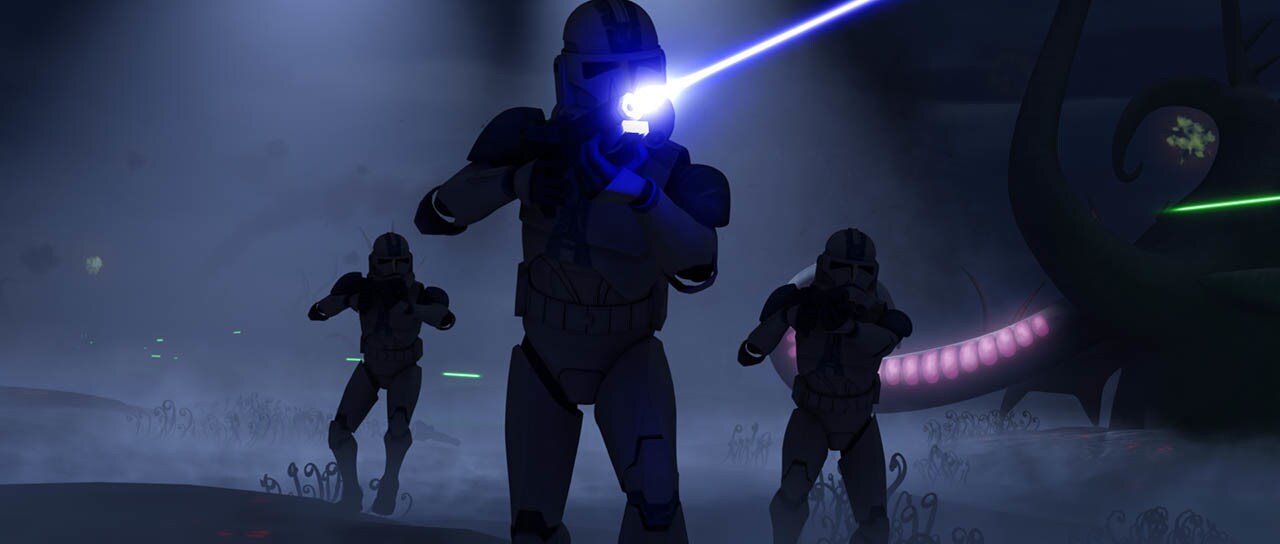Two StarWars.com writers debate their picks for unforgettable storylines in the animated series.
One of the great things about Star Wars is that it inspires endless debates and opinions on a wide array of topics. Best bounty hunter? Most powerful Jedi? Does Salacious Crumb have the best haircut in the saga? In that spirit, StarWars.com presents From a Certain Point of View: a series of point-counterpoints on some of the biggest — and most fun — Star Wars issues. In this installment, two StarWars.com writers take a stand on the most memorable story arc in the Star Wars: The Clone Wars animated series, now streaming on Disney+.
It’s the Umbara arc, says James.
There are a lot of really great storylines in Star Wars: The Clone Wars: exploring the growth and adventures of Ahsoka Tano, discovering mysterious Force entities, and looking at the relationships between characters as the war devours the Jedi and the Republic. But when it comes to picking a single story arc that stands out above the rest, I go back to the adventures on Umbara, a story that focuses almost exclusively on the clones as they grapple with duty and morality under the command of Jedi General Pong Krell.
Like many of the clone-centric stories, we never know where the four-part story could go, because we don’t know the fates of our favorite clones. Thanks to Dee Bradley Baker’s superb acting, we feel the differences between these soldiers despite their common genetic origin. But pretty much any and all of the clones, as well as Pong Krell himself, are entirely expendable.
The battle on Umbara is a challenge enough for the 501st Legion -- in the dim light, clones are lost to unseen monsters and pitfalls of the alien world. The shadowy Umbarans themselves are entrenched and well-suited to defend their world from Republic forces. But add Pong Krell into this heart of literal darkness, and everything is pushed to a breaking point.
Krell is harsh, caring far more about the objective than the casualties, and Rex and Fives almost immediately butt heads with him regarding his tactics that would almost certainly lead to heavy losses. When Fives, Hardcase, and Jesse disobey orders to steal Umbaran fighters for a sneak attack, Rex is put in a tough ethical situation: following the orders of a superior versus protecting the lives of his men. There’s palpable tension when Dogma and Tup try to inform Krell of the rogue mission and it all comes to a head when Krell orders the execution of Jesse and Fives for insubordination and Dogma readies a firing squad.
At this point, I was past the edge of my seat -- were Jesse and Fives really going to be killed by their own squadmates? The two narrowly escape death with a plea to the individuality and humanity of the clones, and the firing squad refuses to shoot the pair. Then Rex and the clones are sent on a strange new mission: to attack Umbaran units that may be disguised in clone armor. In horror, Rex realizes too late that the 501st Legion has engaged against the 212th Attack Battalion. Their opponents are no masquerading enemy, only their fellow clones.
After heavy casualties, including the death of the 212th’s leader Waxer, the clones end the premeditated carnage, and try to confront Krell for his deliberate treachery, and ultimately it’s Dogma who guns the traitorous general down. All of this heavy action has been building on the loyalties of each clone: following foolhardy orders, protecting the lives of their fellow soldiers, and determining what it means to do the right thing. These ethical dilemmas, along with some beautifully eerie battles, make this the most memorable arc in the series.
It's the bombing of the Jedi Temple, says Swapna.
The Clone Wars conflict is incredibly important to Star Wars history, and its impacts are still being felt today. And, by far, the most pivotal character that the series introduced is Ahsoka Tano, Anakin’s Padawan. She embodies everything we’ve been taught a Jedi should be -- goodness, loyalty, a strong sense of morality, dedicated to living a life spent serving others -- and yet, at the end of the fifth season, she was cast out of the Jedi Order.
We saw the Jedi Order at its best and its worst during The Clone Wars, but nowhere was it more misguided than when Ahsoka was accused of bombing the Jedi Temple and the Jedi Council refused to stand by her. Some Jedi argued that they didn’t think she could have done it, but Anakin was the only one who believed in her and steadfastly stood by the person he had come to know and trust. The debate, and the subsequent decisions, showed how weak the Jedi Council had become and directly set the stage for Order 66. And it showed how the Republic-turned-Empire’s war against the Jedi could have come to pass: People had good reason to mistrust the Jedi -- look how they treated one of their own, arguably the best of them.
This arc is unforgettable for so many reasons, but the thing that makes it the most memorable for me is the way it ends. The Jedi vote to strip Ahsoka of her status as a Padawan, functionally abandoning her altogether and allowing the spectacle of a full military trial -- in spite of the fact that many of them (including Plo Koon and Obi-Wan) aren’t even convinced she’s guilty. It speaks to the rot at the core of the Council.
Anakin manages to uncover the true culprit behind the bombing, and shamefaced, the Jedi Order pronounces Ahsoka innocent and invites her to return. But Ahsoka makes a fateful decision: She chooses to walk away from the life she knew, from the corruption she’s seen, and instead forge her own path, according to her own principles.







